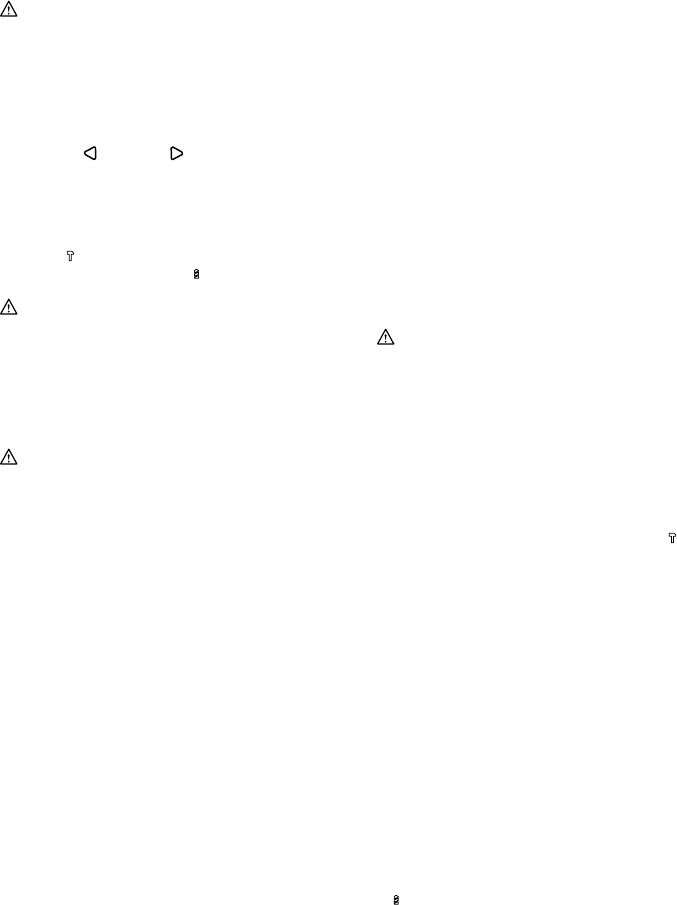
5
for counterclockwise rotation.
CAUTION:
• Always check the direction of rotation before
operation.
• Use the reversing switch only after the tool comes
to a complete stop. Changing the direction of
rotation before the tool stops may damage the tool.
• If the switch trigger can not be depressed, check to
see that the reversing switch is fully set to
position
(A side) or (B side).
Selecting the action mode
Fig.4
This tool has an action mode change lever. For rotation
with hammering, slide the action mode change lever to
the right (
symbol). For rotation only, slide the action
mode change lever to the left (
symbol).
CAUTION:
• Always slide the action mode change lever all the
way to your desired mode position. If you operate
the tool with the lever positioned halfway between
the mode symbols, the tool may be damaged.
ASSEMBLY
CAUTION:
•
Always be sure that the tool is switched off and
unplugged before carrying out any work on the
tool.
Installing side grip (auxiliary handle)
Fig.5
Always use the side grip to ensure operating safety.
Install the side grip on tool barrel.
Then tighten the grip by turning clockwise securely at
the desired position. It may be swung 360° so as to be
secured at any position.
NOTE:
• The side grip cannot swing 360° when the depth
gauge is installed.
Installing or removing drill bit
For Model HP1640, HP1640F
Fig.6
To install the bit, place it in the chuck as far as it will go.
Tighten the chuck by hand. Place the chuck key in each
of the three holes and tighten clockwise. Be sure to
tighten all three chuck holes evenly.
To remove the bit, turn the chuck key counterclockwise
in just one hole, then loosen the chuck by hand.
After using the chuck key, be sure to return to the
original position.
For Model HP1641, HP1641F
Fig.7
Hold the ring and turn the sleeve counterclockwise to
open the chuck jaws. Place the bit in the chuck as far as
it will go. Hold the ring firmly and turn the sleeve
clockwise to tighten the chuck.
To remove the bit, hold the ring and turn the sleeve
counterclockwise.
Depth gauge
Fig.8
The depth gauge is convenient for drilling holes of
uniform depth. Loosen the side grip and insert the depth
gauge into the hole in the side grip. Adjust the depth
gauge to the desired depth and tighten the side grip.
NOTE:
• The depth gauge cannot be used at the position
where the depth gauge strikes against the tool
body.
OPERATION
Hammer drilling operation
Fig.9
CAUTION:
• There is a tremendous and sudden twisting force
exerted on the tool/bit at the time of hole
break-through, when the hole becomes clogged
with chips and particles, or when striking
reinforcing rods embedded in the concrete. Always
use the side grip (auxiliary handle) and firmly hold
the tool by both side grip and switch handle during
operations. Failure to do so may result in the loss
of control of the tool and potentially severe injury.
When drilling in concrete, granite, tile, etc., move the
action mode changing lever to the position of
symbol
to use "rotation with hammering" action.
Be sure to use a tungsten-carbide tipped bit.
Position the bit at the desired location for the hole, then
pull the switch trigger. Do not force the tool. Light
pressure gives best results. Keep the tool in position and
prevent it from slipping away from the hole.
Do not apply more pressure when the hole becomes
clogged with chips or particles. Instead, run the tool at
an idle, then remove the bit partially from the hole. By
repeating this several times, the hole will be cleaned out
and normal drilling may be resumed.
Blow-out bulb (optional accessory)
Fig.10
After drilling the hole, use the blow-out bulb to clean the
dust out of the hole.
Drilling operation
When drilling in wood, metal or plastic materials, move
the action mode changing lever to the position
of
symbol to use "rotation only" action.
Drilling in wood
When drilling in wood, the best results are obtained with
wood drills equipped with a guide screw. The guide
screw makes drilling easier by pulling the bit into the
workpiece.


















